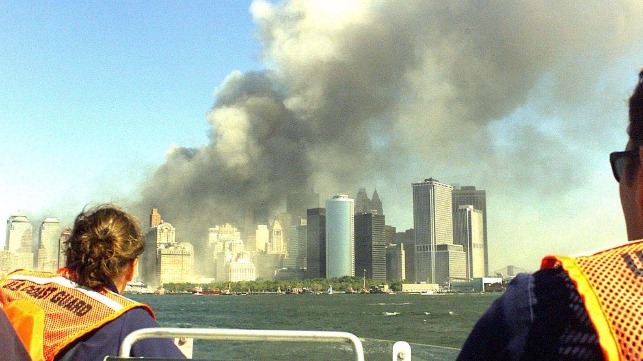Remembering the Heroes of 9/11 and the Lower Manhattan Boatlift

Friday marks the 19th anniversary of the 9/11 attacks, which killed almost 3,000 people in Manhattan, Pennsylvania and Washington, D.C. Though COVID-19 has changed the way that Americans gather to honor the fallen this year, ceremonies and virtual gatherings around the United States - and the world - have carried on.
In Manhattan, Vice President Mike Pence and Democratic presidential candidate Joe Biden attended a ceremony at the 9/11 Memorial and Museum. With six feet of social distancing, fist bumps and face masks, the proceeding had a much different appearance than last year, but its solemnity and purpose were unchanged.
We will never forget. ???????? pic.twitter.com/XOkmwth8UD
— Mike Pence (@Mike_Pence) September 11, 2020
Coronavirus risks nearly canceled the museum's "Tribute in Light" display, an iconic array of 88 lights pointed upwards in an outline of the twin World Trade Center towers. In August, the organization announced that it did not wish to expose its workers and contractors to the risk of COVID-19 during setup, and it would cancel the project to assemble the display for this year. After objections from the public, the museum said that it would proceed, but with additional safety arrangements. With backing from New York Gov. Andrew Cuomo and former mayor Mike Bloomberg, the work was completed on time. The light display came on at nightfall on Friday, giving New Yorkers a tangible reminder of the original towers.
Remembering the 9/11 boatlift
The first responders to the 9/11 attacks in New York included hundreds of mariners and coastguardsmen, who worked together to evacuate Lower Manhattan. The U.S. Coast Guard organized a boatlift effort that rescued thousands of people: five cutters, 12 Coast Guard patrol boats and over 100 civilian vessels picked up survivors from the water's edge near Wall Street. Ground transporation was shut down by the attack, and local mariners aboard tugs, harbor cruise boats, small ferries and water taxis were a critical part of the evacuation.
This year, the Navy League Council of New York held a virtual roundtable with some of the men who were at the scene and helped lead the massive boatlift. Many recalled thinking that there had been a terrible accident when the first plane struck the North Tower at 0846 hours that morning. At 0903, when United Airlines Flight 175 hit the South Tower, it became clear that the city was under attack - and a large-scale evacuation would be required. Under the leadership of Lt. Mike Day, local Coast Guard units marshalled a force of volunteer mariners to pick up survivors and carry them across the harbor to safety.
"Everybody wanted to help, even the small [commercial] dive boats," recalled Andrew McGovern, the president of the Sandy Hook Pilots Association. "One of the things we were really worried about was people falling in [while boarding]. We asked the dive boats, you know, you're a safety boat. If anything happens, you've got the swimmers and the equipment, give them help."
The organizers relied on an evacuation contingency plan for Lower Manhattan that had been written the year before, and the effort unfolded naturally, with everyone pitching in and doing whatever they could. Coast Guard marine inspectors volunteered to go the scene and supervise safe loading - not based on each boat's COI, but on a practical estimate of the maximum number of people each could carry in an emergency. "They made risk-based decisions that turned out to be very effective," said Capt. Dan Ronan (USCG, ret'd), who was serving as the head of New York's VTS system at the time of the attacks.
The integrated response effort prefaced what the federal government would later institutionalize in the form of the Department of Homeland Security. "State, local, and federal [agencies], everyone just worked together . . . we didn't have a Department of Homeland Security yet, but we were all acting in that capacity," said Capt. Daniel Croce (USCG, ret'd).
After the evacuation was over, the boatlift continued for days, bringing supplies to the first responders working in Lower Manhattan. Regardless of which company they worked for, relief boats shared fuel with each other to keep running, McGovern recalled. They also supplied the firefighting effort with diesel.
"All the water mains in Manhattan were gone because the power was out, so the only way we could get water to the fires was from the river. There were fire boats docked along the west side of Manhattan with hoses up onto the pier, and then it would be relayed by pumper trucks to get the water pressure up and get it into the middle of the island. Mariners were literally putting diesel fuel into five-gallon water jugs and carrying it to resupply those pumper trucks for the next few days," McGovern said.
Ultimately, that terrible day also demonstrated the value of the American maritime industry in time of need. "When I think about the role of the maritime industry, the ferries, the tugs, the pilots - you know, they assisted hundreds of thousands of people on 9/11 and saved a lot of lives by conducting a safe and rapid evacuation," said Vice Adm. Mike McAllister (USCG). "It was a scary time for everybody, there was the threat of a tower collapse and what impact that might have on the waterfront, there was the risk of another terrorist action, so their ability to come together in a time of great uncertainty is admirable."
